Abstract
The Article presents current research on digital competences in the international educational space, the European Commission’s policies in the field of education (DigCompEdu: Digital Education Framework), and gives a brief overview of the activities implemented and the results obtained after implementing the school evaluation with the use of SELFIE (Self-reflection on Effective Learning by Fostering the use of Innovative Educational technologies), a tool developed by a team of experts from schools, education ministries and European research institutes, and funded by the European Commission. The research presented was conducted at “Petru Rareș” National College, Beclean, in the 2020-2021 school year and emphasizes the use of technology and the results of the self-assessment completed by students, teachers and school leaders from this case-study school, because this self-assessment tool, SELFIE, helps schools to take a snapshot of where they stand in their use of digital technologies, taking on board views of teachers, students and school leaders.
Keywords: DigCompEdu, digital competences, key competences, public policies, SELFIE, tools
Introduction
Due to the significance of building digital competences in today's education, we have compiled an inventory of European approaches and policies to assist teachers and schools in becoming digitally aware. The objective of this article is to describe the potential of the resources provided by the European Commission for school education, focusing on the resources regarding the development of digital competences (DigCompEdu –) and on presenting a tool that can be used as a means of collecting valuable data about educational institutions.
The research was conducted with the use of SELFIE (at “Petru Rareș” National College, a case-study school participating to the EduNetworks interventions on digital education, as part of the Bistrița-Năsăud Schools Cluster, in the 2020-2021 school year.
The purpose of this study was to review and receive input on how students and teachers from “Petru Rareș” National College use digital tools and technologies in their teaching and learning activities.
Problem Statement
Competences are a fusion of information, abilities, and attitudes. Competence is defined in the National Education Law (1/2011), Appendix 1 – “The list of terms and expressions definitions used in the law” as the “the proven ability to select, combine and use adequate knowledge, skills and other acquisitions consisting of values and attitudes, to successfully solve certain categories of work or learning-related situations, in addition, to develop professionally or personally in terms of effectiveness and efficiency”. According to "The Praxeological Dictionary of Pedagogy" (Bocoş et al., 2016), competences are the outcome of a dynamic interaction, specialized to one scenario but adaptable to others, nearly logically equivalent with the current situation, and related within the same group of situations: “Being competent means knowing how to act qualitatively, efficiently and promptly in a category/class of similar or atypical situations”.
European Council (2018) identifies key competences (in Council Recommendation on Key Competences of May 22, 2018) as “those which all individuals need for personal fulfilment and development, employability, social inclusion, sustainable lifestyle, successful life in peaceful societies, health-conscious life management and active citizenship. They are developed in a lifelong learning perspective, from early childhood throughout adult life, and through formal, non-formal and informal learning in all contexts, including family, school, workplace, neighbourhood and other communities”. These are literacy competence; multilingual competence; STEM competence; digital competence; personal, social competence; citizenship competence; entrepreneurship competence and cultural awareness. These key competences contribute to the development of skills like: critical thinking, team-work, problem-solving, communication skills, negotiation skills, analytical skills, creativity, and intercultural skills.
Information and Communication Technology in Education. Dictionary of terms (Baciu et al., 2022) presents the concept of key-competences as "a transferable and multifunctional package of competences that have to be developed as part of the compulsory education and that are required by all individuals, as a fundament of future learning, as part of lifelong learning".
The European Council defines digital competence, one of the core competencies, as follows in its Council Recommendations on Key Competencies for Lifelong Learning from May 22, 2018 (published in the Official Journal of the European Union, 2018): “the confident, critical and responsible use of, and engagement with, digital technologies for learning, work, and for participation in society. It includes information and data literacy, communication and collaboration, media literacy, digital content creation (including programming), safety (including digital well-being and competences related to cybersecurity), intellectual property-related questions, problem solving and critical thinking”.
Digital competence is emphasized as a major competency in The Praxeological Dictionary of Pedagogy (Bocoş et al., 2016), which incorporates the secure and analytical use of technology as a tool for learning and knowledge in particular (for employment, leisure time, and communication), presenting it as “the mastery of information and communication technologies as a tool of knowledge and learning: the use of the computer to obtain, evaluate, store, produce, present and exchange information and to communicate and participate via the Internet in collaborative networks”, encouraging the development of additional competences.
The priorities for the Digital Education Action Plan are identified by the European Commission, 2018 (in Communication from The Commission to The European Parliament, The Council, The European Economic and Social Committee and The Committee Of The Regions on the Digital Education Action Plan) as: “Making better use of digital technology for teaching and learning; Developing relevant digital competences and skills for the digital transformation and Improving education through better data analysis and foresight”.
The Digital Education Action Plan 2021-2027 (https://education.ec.europa.eu/focus-topics/digital-education/about/digital-education-action-plan) “is a renewed European Union (EU) policy initiative to support the sustainable and effective adaptation of the education and training systems of EU Member States to the digital age”. A detailed framework outlining digital competency in further depth was first published at the European level in 2013 and has since been an information resource for the development and strategic planning of digital competence initiatives at both European and Member State levels. However, as the digitalisation of our society, work and education is moving fast, there is a need to update the concepts and vocabulary of the DigComp framework. The Digital Education Action Plan builds on the two Communications adopted in May 2017: A renewed EU Agenda for Higher Education and School development and excellent teaching for a great start in life. Both on a national and a European level, it has evolved into a shared reference tool. The Digital Education Plan sets out 2 priority areas, as presented in Table 1: 1. fostering the development of a high-performing digital education ecosystem; 2. Enhancing digital skills and competences for the digital transformation.
The Digital Competence Framework 2.0 (2016) divides digital competence into five areas, namely, information and data literacy, communication and collaboration, digital content creation, safety, and problem solving.
The latest version of the European Digital Competence Framework was released in 2017, DigComp 2.1: The Digital Competence Framework for Citizens, published in 2017 by Carretero et al. has eight skill levels and usage examples. Table 2 contains the competence areas and the competences identified as part of Digital Competence Framework for Citizens.
DigCompEdu, as shown in Figure 1, lists 22 skills, organised in six areas. Technical proficiency is not the main focus. The framework instead tries to describe how digital technologies might be applied to improve and reinvent education and training. It concentrates on the professional competencies of educators (such as professional involvement), their pedagogical competencies (such as digital content, pedagogical practices, evaluation, and learner engagement and motivation), and the competencies of students (such as developing students' digital skills).
The following skills are essential for teachers' professional competences: communication process, professional interaction and teamwork, reflexivity, and digital continual professional growth. Teachers' pedagogical competencies must include the use of digital resources (helpful for creating material), assessment (techniques, planning, and feedback), teaching (facilitation, cooperation, and life-long learning), as well as learner empowerment. It is critical to place more emphasis on students' competencies than only educators' professional and/or pedagogical abilities.
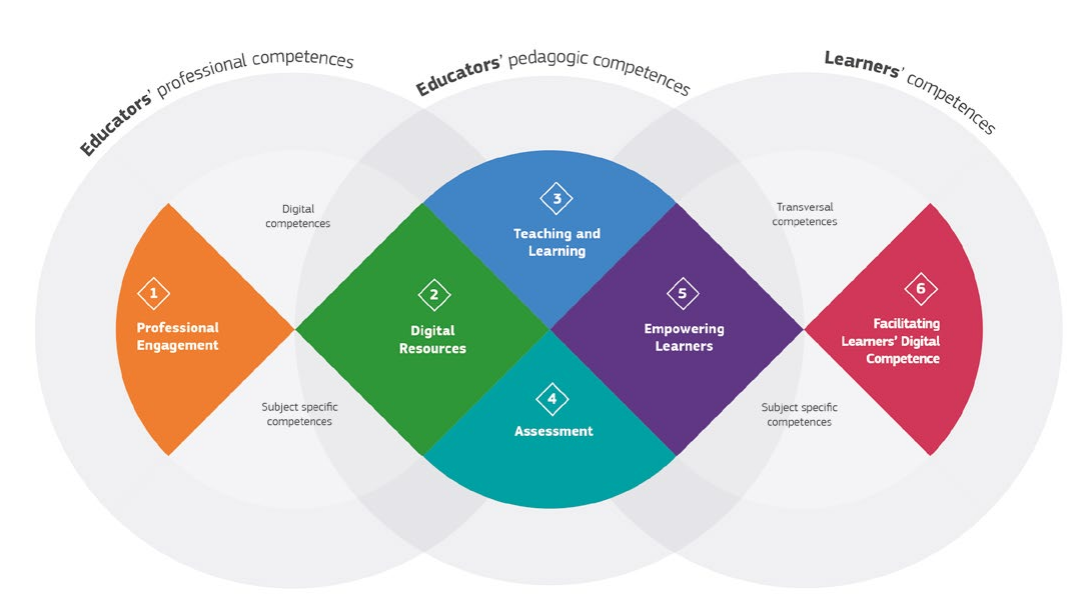
In table 3, we present the competence areas and the competences required by educators, according to the DigCompEdu framework, as well as aspect of educators` professional activities, as presented as part of the DigCompEdu tool, published by Redecker (2017).
DigCompEdu also offers a level of progression for educators to evaluate their DigCompEdu proficiency progression, by areas and to develop their digital competences. The levels of progression are: A1 – Newcomer; A2 – Explorer; B1 – Integrator; B2 – Expert; C1 – Leader; C2 – Pioneer.
According to the European Commission’s report, “The Digital Economy and Society Index — Countries' performance in digitisation” (2021), Digital Economy and Society Index (DESI) 2021, reports based on 2020 data and presenting the state of the digital economy and society in the first year of the pandemic, in the edition from 2021, Romania is ranked 27th out of 27 EU Member States (as shown in Figure 2 below). Romania is ranked 26th in terms of human capital, scoring under average on the majority of categories. Despite having the fourth-highest number of ICT graduates, the country's ability to innovate and benefit from the digital transformation is constrained by the lack of ICT specialists. Romania is ranked third among female ICT specialists, in comparison. Romania is ranked 7th in terms of connectivity, despite fixed broadband coverage progressing in 2020 (52% adoption of at least 100Mbps). By concentrating on closing the digital divide between urban and rural areas, expediting the permit-granting process, upgrading the broadband strategy to reflect the 2025 gigabit ambitions, and more, connectivity in Romania might be made even better.
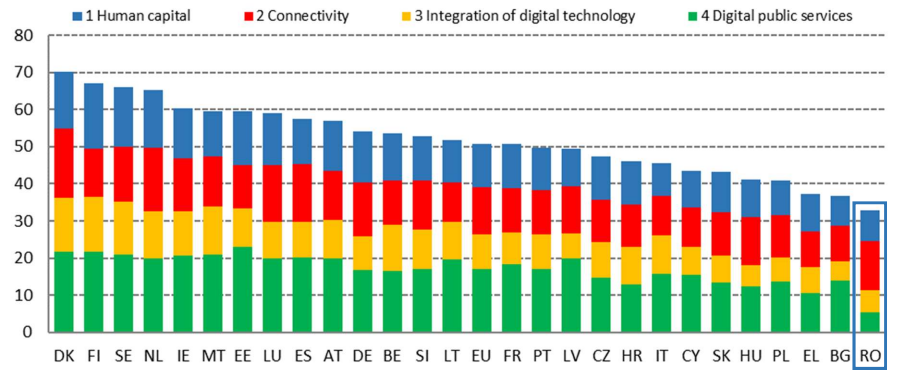
Romania's human capital index is well below the EU average, according the DESI assessment from 2021. In the EU as a whole, 56% of persons between the ages of 16 and 74 have at least basic digital abilities, while 35% possess at least basic programming skills. Only 10% of people possess more advanced digital skills. ICT specialists still make up a significantly smaller share of the workforce than they do in the EU in general (2.4% versus an EU average of 4.3%), notwithstanding a slight increase in their percentage. There are only 6% of businesses in Romania that offer Training programmes to their staff members, which is a very low percentage, comparing to the European average, that is 20%. In opposition, Romania excels when it comes to ICT graduates, ranking highly among the EU Member States with 6.3% of all graduates, and female ICT professionals, who constitute 26% of all ICT specialists.
To address the necessary digitalisation of education, in October 2020 the Ministry of Education launched the 2021-2027 SMART.Edu strategy on the digitalisation of education in Romania. The strategy’s two main strands are: digital skills relevant to the digital transformation and developing a high-performance digital education and training ecosystem.
Romania still has a long way to go in terms of digitization, digital education and digital skills, as shown in the official reports. Also, if we take into consideration the needs of students, the needs of teachers and the ones of the educational institutions, we have to identify appropriate tools and approaches that can contribute to the development of educational institutions in terms of digital education. In this regard, numerous projects and tools have been developed by the European Commission, to support the direction of digitalization in education. In the first part of this paper presented the DigCompEdu framework and we will continue with a focus on SELFIE (Self-reflection on Effective Learning by Fostering the use of Innovative Educational technologies). SELFIE is a free tool for institutional development, which evaluates school organizations providing a unitary image of the aspects regarding the use of technology in school and how the weaknesses associated with it can be improved. SELFIE anonymously gathers the views of students, teachers and school leaders on how technology is used in their school. This is done using short statements and questions and a simple 1-5 answer scale. The questions and statements take around 20 minutes to complete. Based on this input, the tool generates a report – a snapshot (‘SELFIE’ :-)) of a school‘s strengths and weaknesses in their use of technology. SELFIE is available for any primary, secondary and vocational schools in Europe and beyond, and in over 30 languages. It can be used by any school – not just those with advanced levels of infrastructure, equipment and technology use (European Commission, 2019a).
Research Questions
The research was conducted at “Petru Rareș” National College, in the first therm of 2020-2021 school year (30 November – 15 December 2020). In this article, the following questions were explored, on primary, lower secondary and upper secondary level:
How could the SELFIE tool help our school to assess where we stand with learning in the digital age?
Does the school have a vision for how it wants to use technology and, if so, do staff and students know what it is?
How can school improve how it uses technology for teaching and learning?
Purpose of the Study
In order to identify the key priorities for the school's educational plan for 2021–2027, which will be a part of the school's plan for the School Education Erasmus Accreditation, the study's primary goal is to quantitatively analyze teachers', students', and school managers' perceptions of how technology is used in their school, respectively, at Colegiul Național „Petru Rareș” Beclean.
Research Methods
The research methods used were observation, analysis of students’ work and a questionnaire-based survey, applied to primary, lower and upper secondary students and teachers from „Petru Rareș” National College Beclean, in the 2020-2021 school year, between 30 November – 15 December 2020.
The areas targeted by the SELFIE questionnaire were: school leadership, collaboration with other schools/organisations; networking (partnerships initiated by the school); infrastructure and equipment; continuing professional development; pedagogy: students` collaboration, engaging students in curricular activities, integrating digital tools to meet each student's unique requirements, incorporating digital learning into creative endeavors, and getting students involved in cross-curricular projects, assessment practices and students` digital competences.
The SELFIE questionnaire (Self-reflection on Effective Learning by Fostering the use of Innovative Educational technologies) is a free tool designed to help schools embed digital technologies into teaching, learning and assessment and is an initiative of the European Commission, funded through the Erasmus program. It has been developed with a team of experts from schools, education ministries and research institutes across Europe. Partner institutions include the European Training Foundation, the European Centre for the Development of Vocational Training (CEDEFOP) and UNESCO's Institute for Information Technologies in Education. European Commission (2019b) states that SELFIE s “supporting schools for learning in the digital age” and, through it, offers resources and contributes to discovering the digital potential of the schools.
While some questions from SELFIE are mandatory for all institutions and cannot be changed, others are optional, so each institution can choose whether or not to include them based on their applicability. The current questionnaire only included the common and the optional questions, we did not add any customized questions. Table 4 presents the areas of interests and also, the items related to each one of them, as well as the code used for each one: leadership; collaboration and networking; infrastructure and equipment; professional development; pedagogy, assessment practices and students` digital competence.
As part of our research, the SELFIE questionnaires were completed for all the 3 levels of school education from “Petru Rareș” National College (primary, lower secondary and upper secondary), as emphasized in Figure 3, with the percents of completion for school leaders, teachers and students, for all the three levels existing at “Petru Rareș” National College Beclean:
5.1. Primary school: 118 primary school students; 5 primary school teachers and 2 headmasters;
5.2. Lower secondary school: 124 lower secondary students, 19 teachers and 2 headmasters;
5.3. High school: 478 upper secondary students, 30 teachers and 2 school leaders
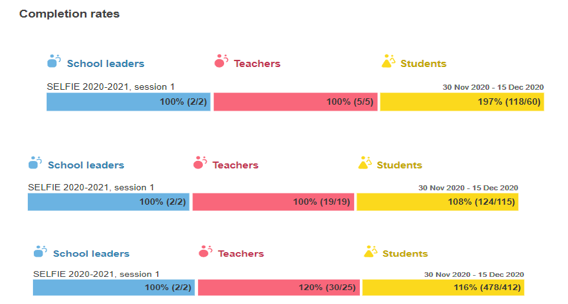
Findings
The SELFIE questionnaires for primary school were completed by 118 students, 5 primary school teachers and 2 headmasters from ”Petru Rareș” National College Beclean. Comparing the answers to the common questions, we can notice that all respondents mentioned the need for Infrastructure and Equipment (question C8 was about digital devices for all students; question C7 was referring to data protection services). The main challenges identified by all respondents were infrastructure (for online and blended learning activities).
Figure 4 shows the completion of the SELFIE tool by the primary school students, with focus on the areas of interest for this level (infrastructure and equipment; pedagogy: implementation in the classroom; student digital competences; collaboration and networking.
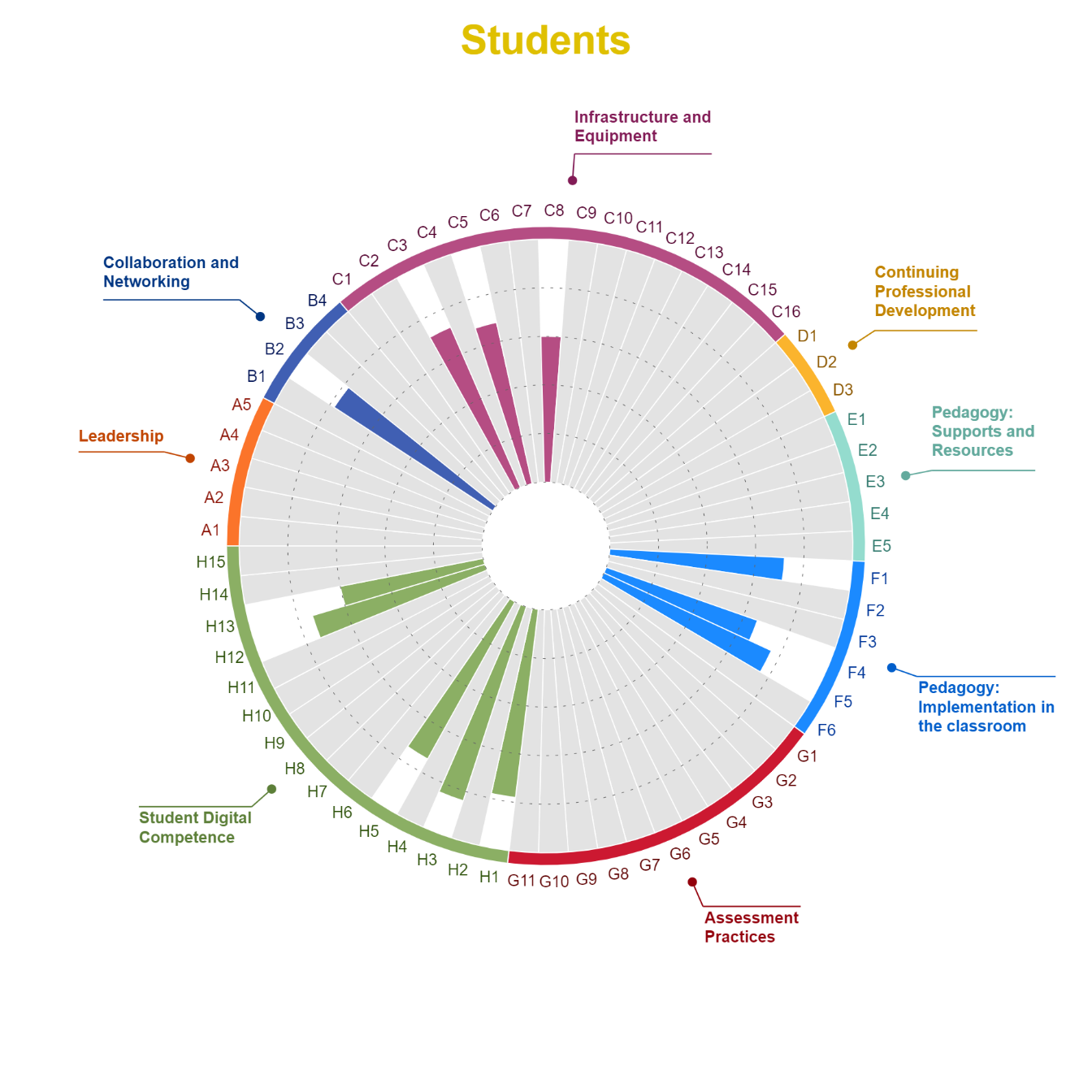
The following diagram (Figure 5) shows the answers provided by the primary school teachers.
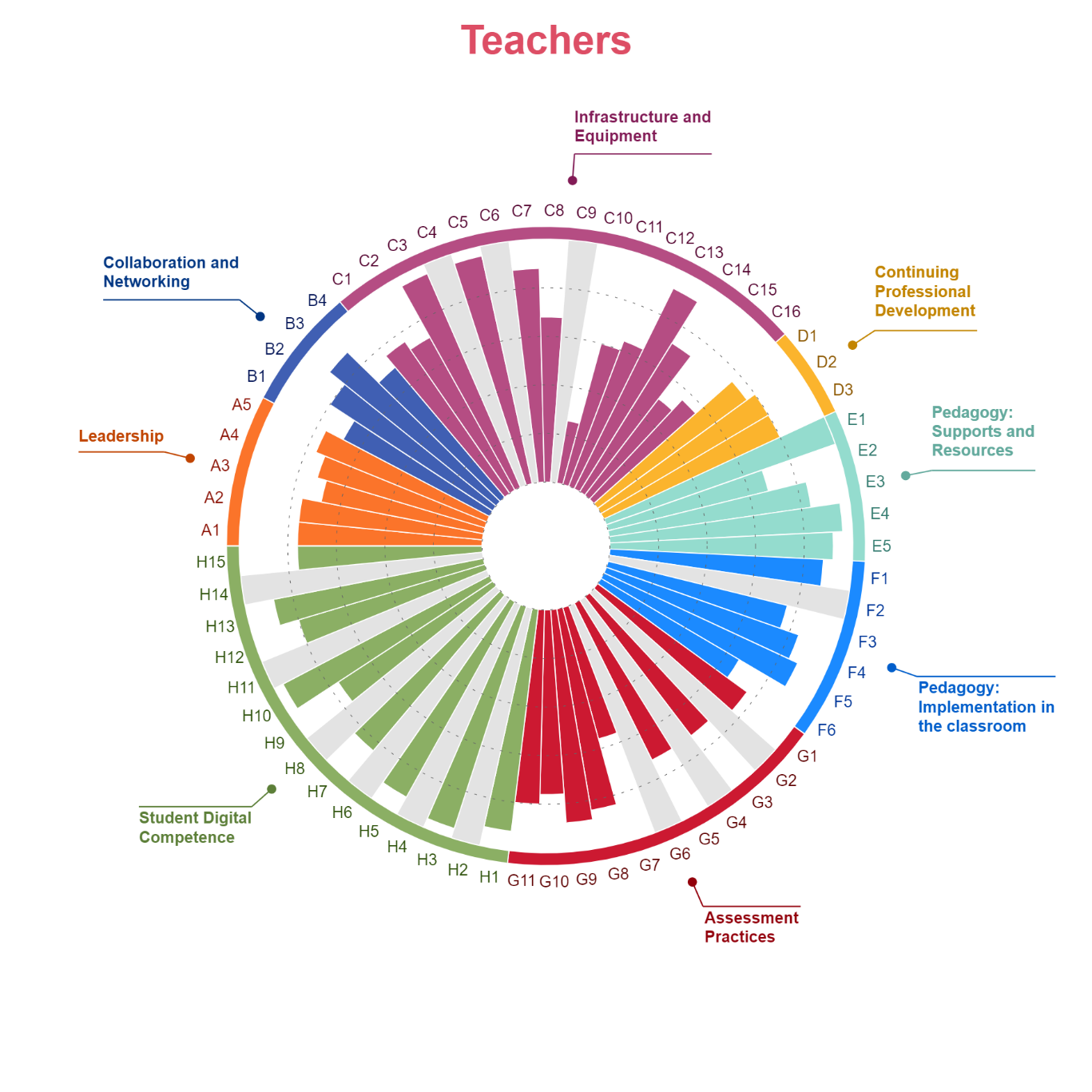
Figure 6 illustrates the vision of the school administration by emphasizing the requirement for IT infrastructure and equipment. More critical than reflections from students or teachers are the answers provided by headmasters. The areas deemed to be most effective are networking and collaboration.
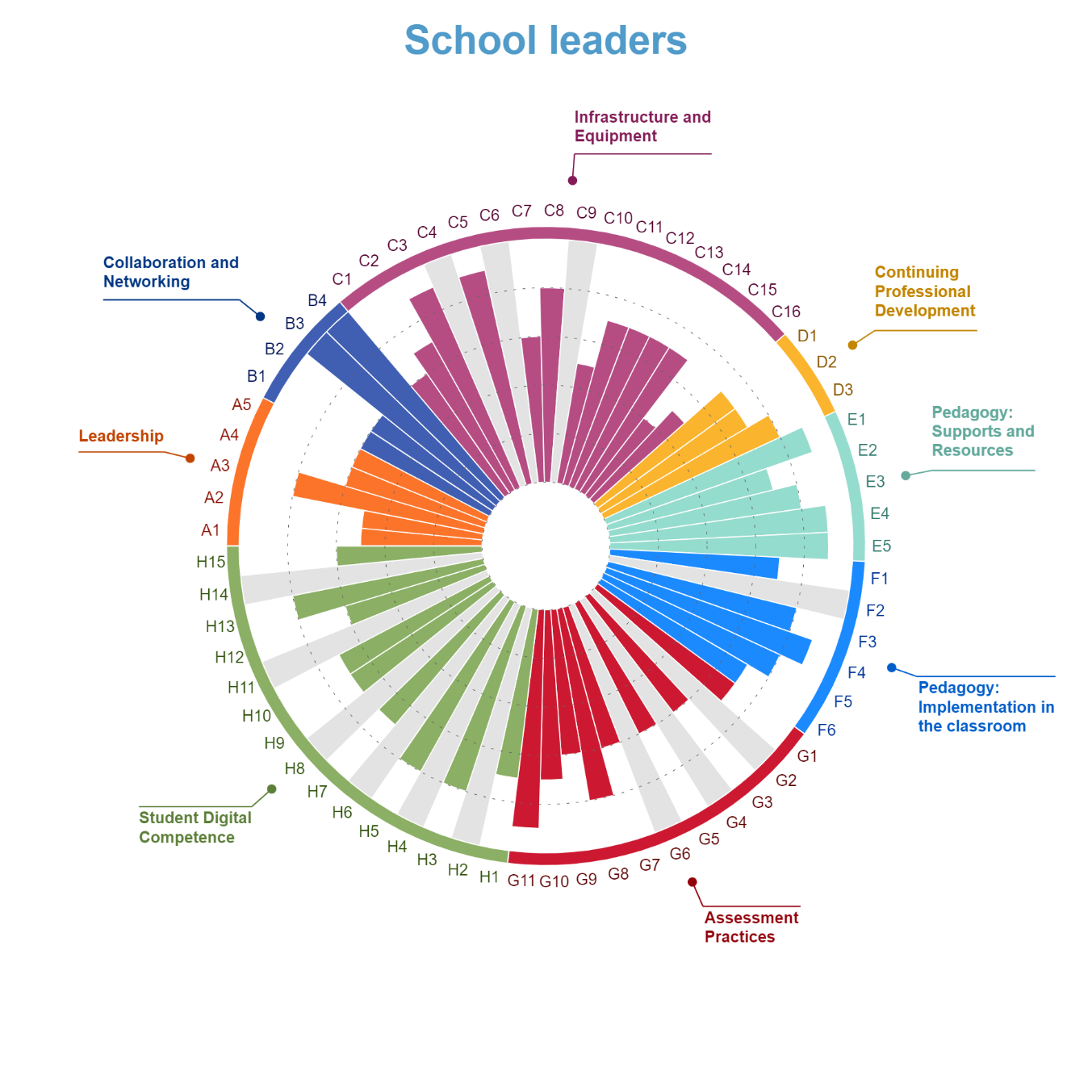
The SELFIE questionnaire for lower secondary school was completed by 124 gymnasium students, 19 teachers and 2 headmasters. The answers provided by students, presented in Figure 7, identified the main institutional challenges for question C10 (In our school there are school owned and managed portable devices that students can take home when needed?). From the special challenges from the school leaders` questionnaire, we noticed the challenges related to access to assistive technologies for students requiring special support.
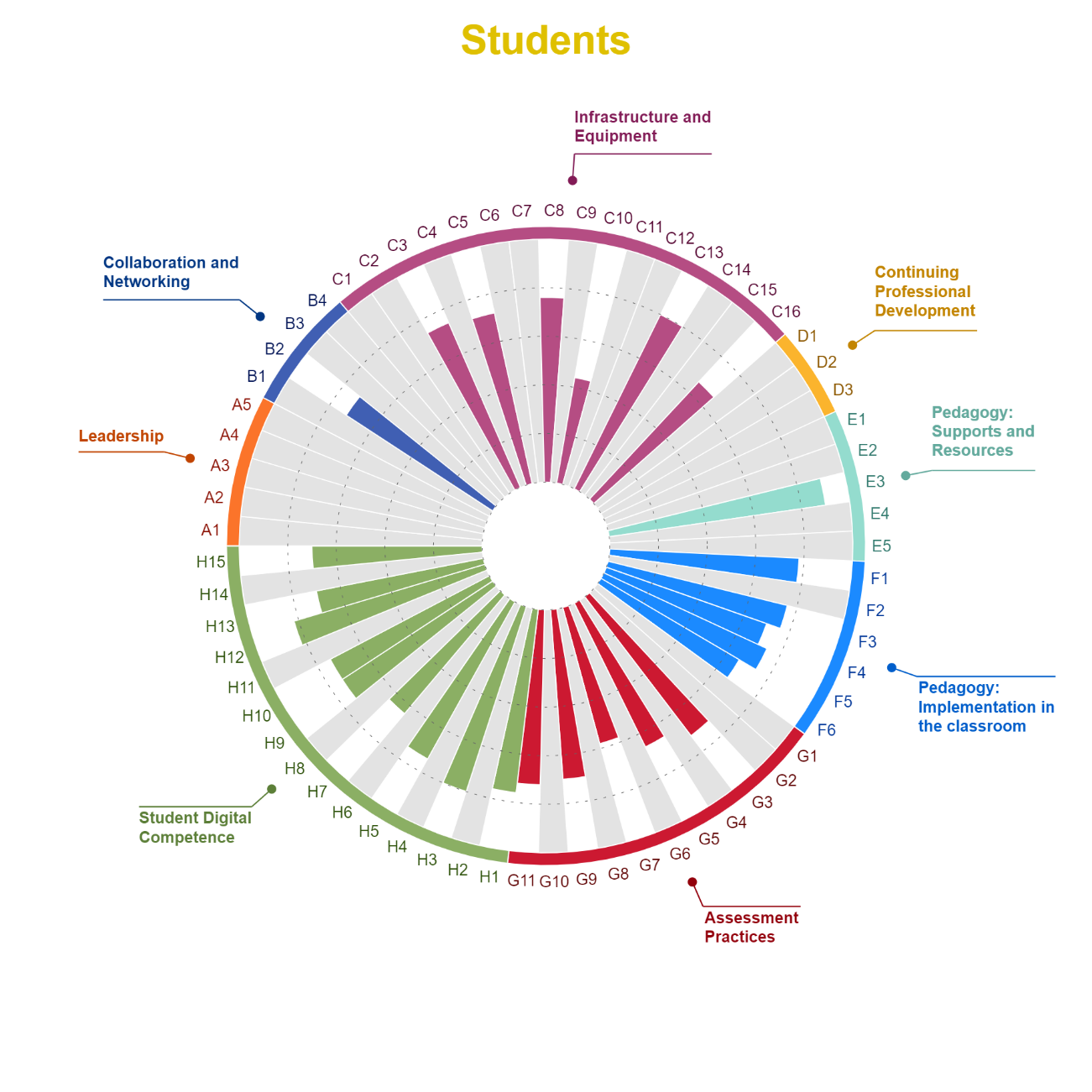
Figure 8 depicts the perspective of instructors in the lower secondary grades, with a similar emphasis on the insufficiency of IT infrastructure and tools.
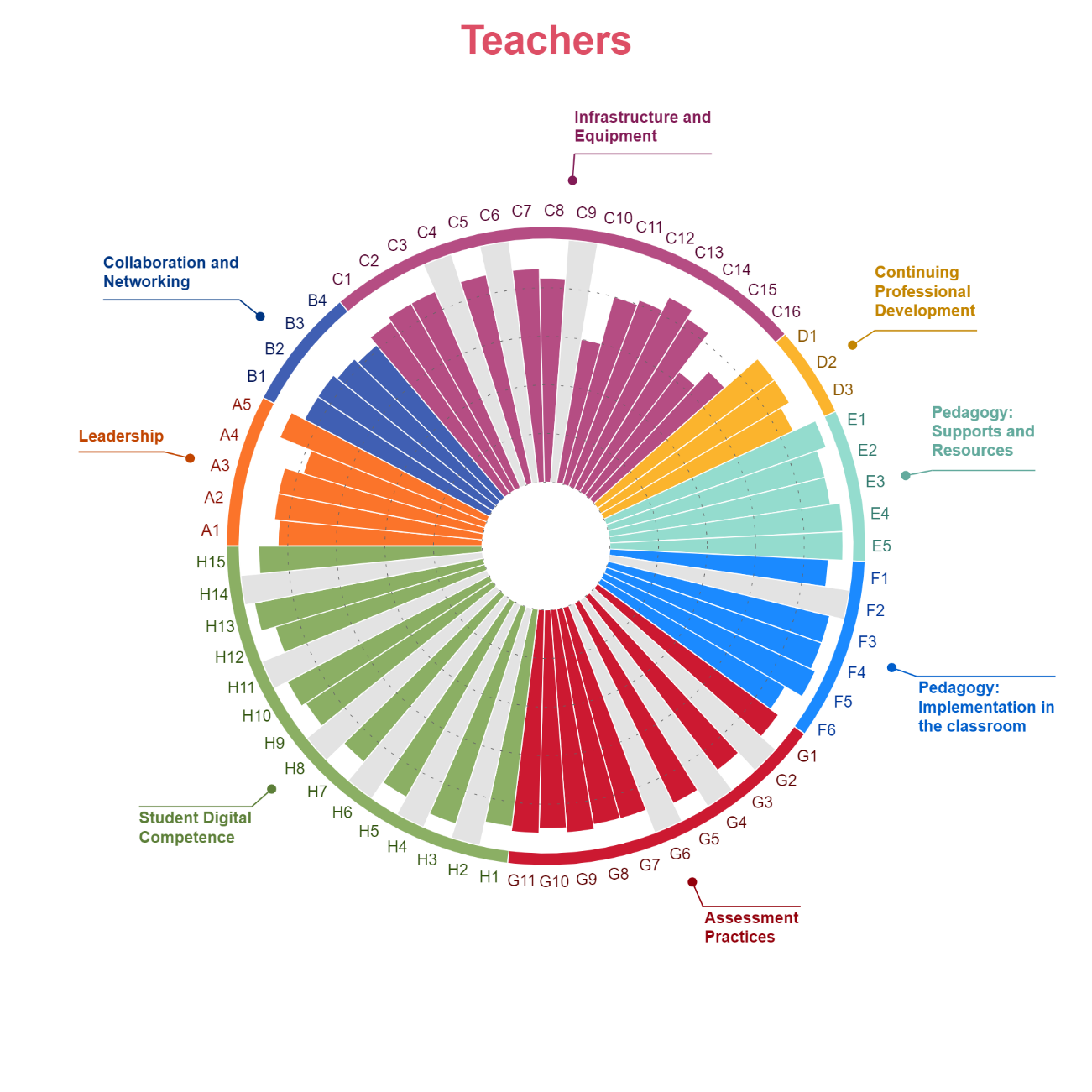
The next graphic (Figure 9) shows the viewpoint of school administrators in the lower secondary classes. It places a similar emphasis on the lack of IT infrastructure and tools, with C15 receiving the lowest marks.
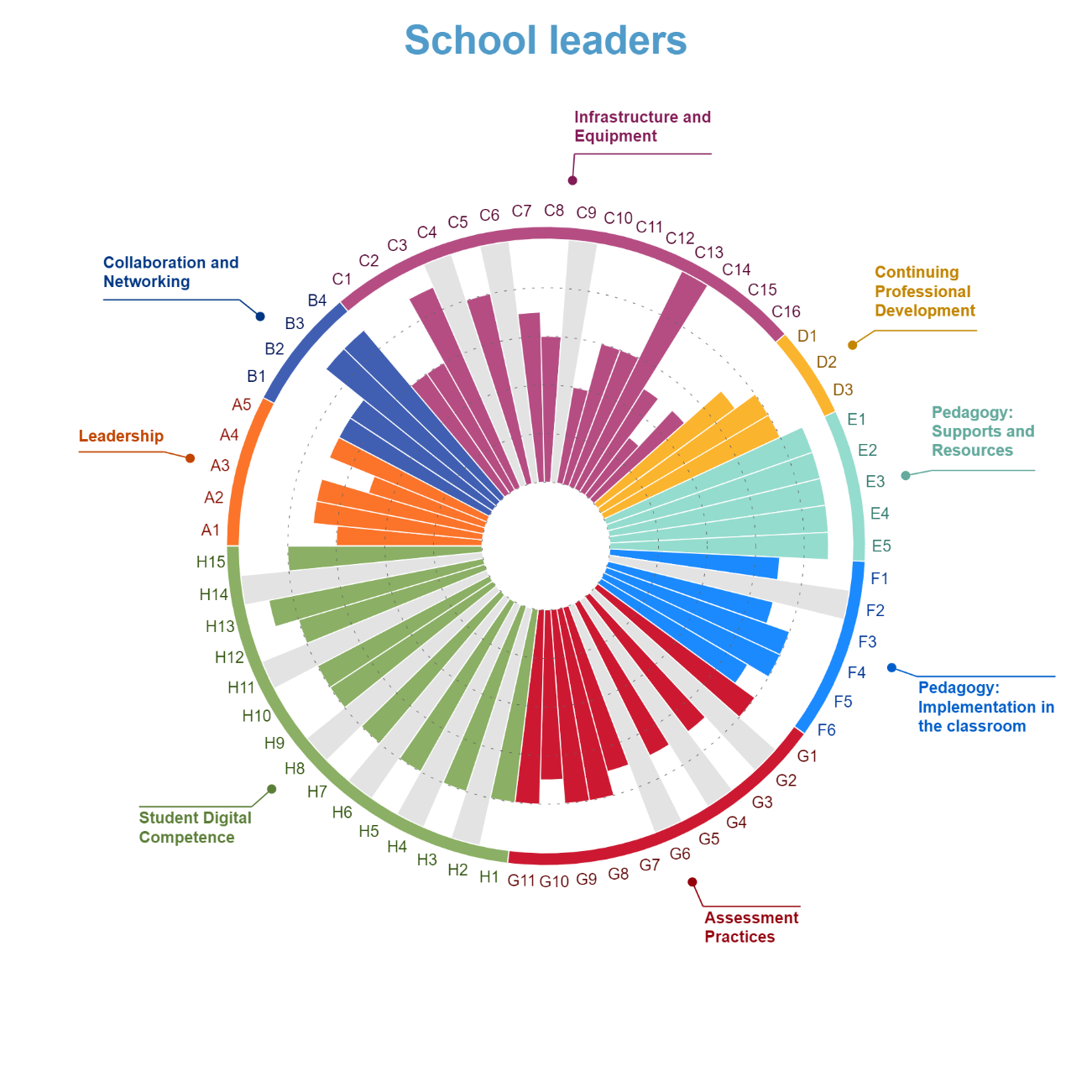
478 upper secondary students, 30 instructors, and 2 school leaders completed the SELFIE questionnaire for upper secondary school. The responses put emphasis on the challenges teachers and students in high school face. As seen in the following graphic (Figure 10), finding the right digital gadget for each student is the largest issue.
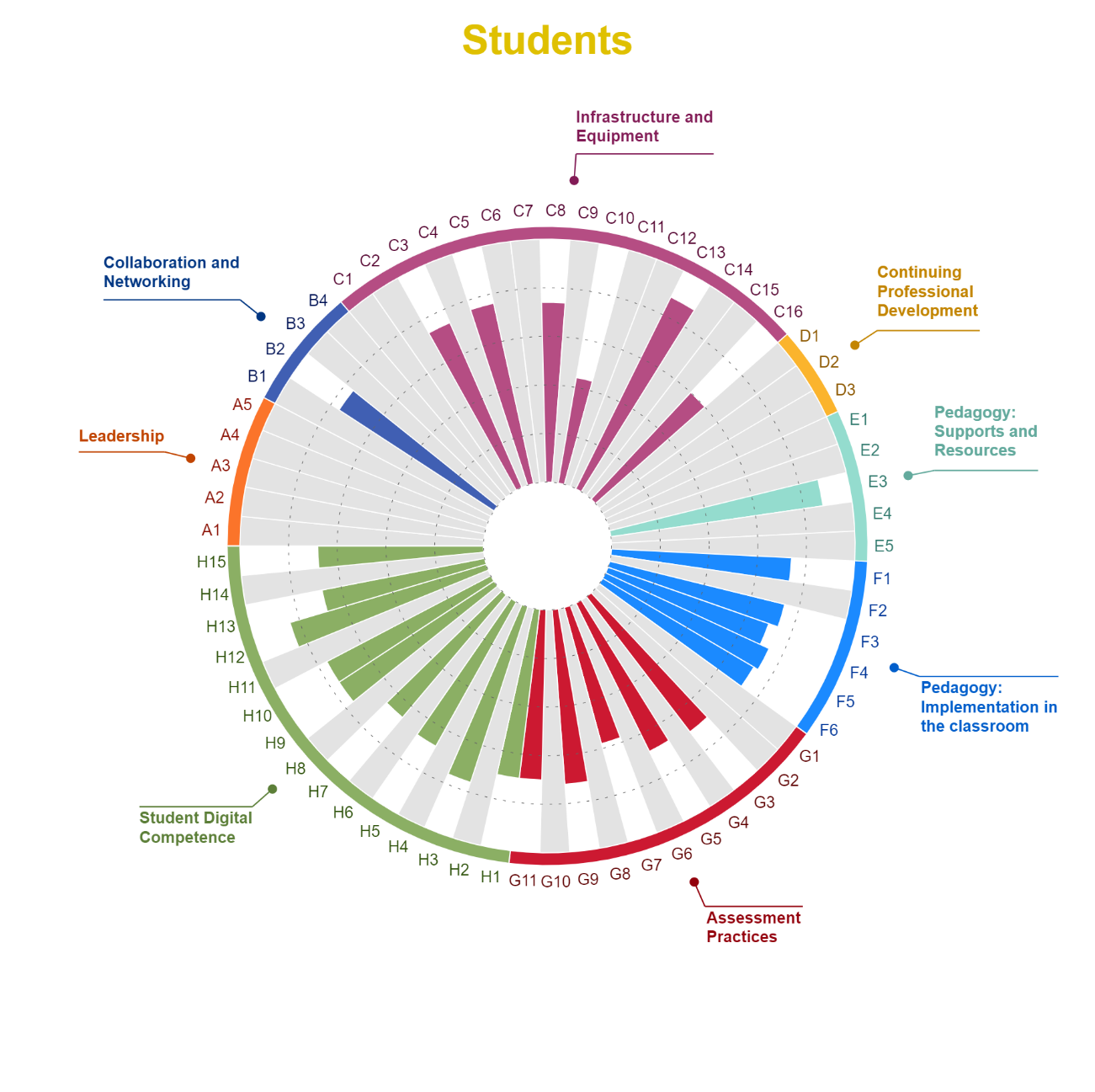
The following image (Figure 11) points out the feedback received from teachers, with similar points of observation and needs` analysis as the ones received from students and school leaders.
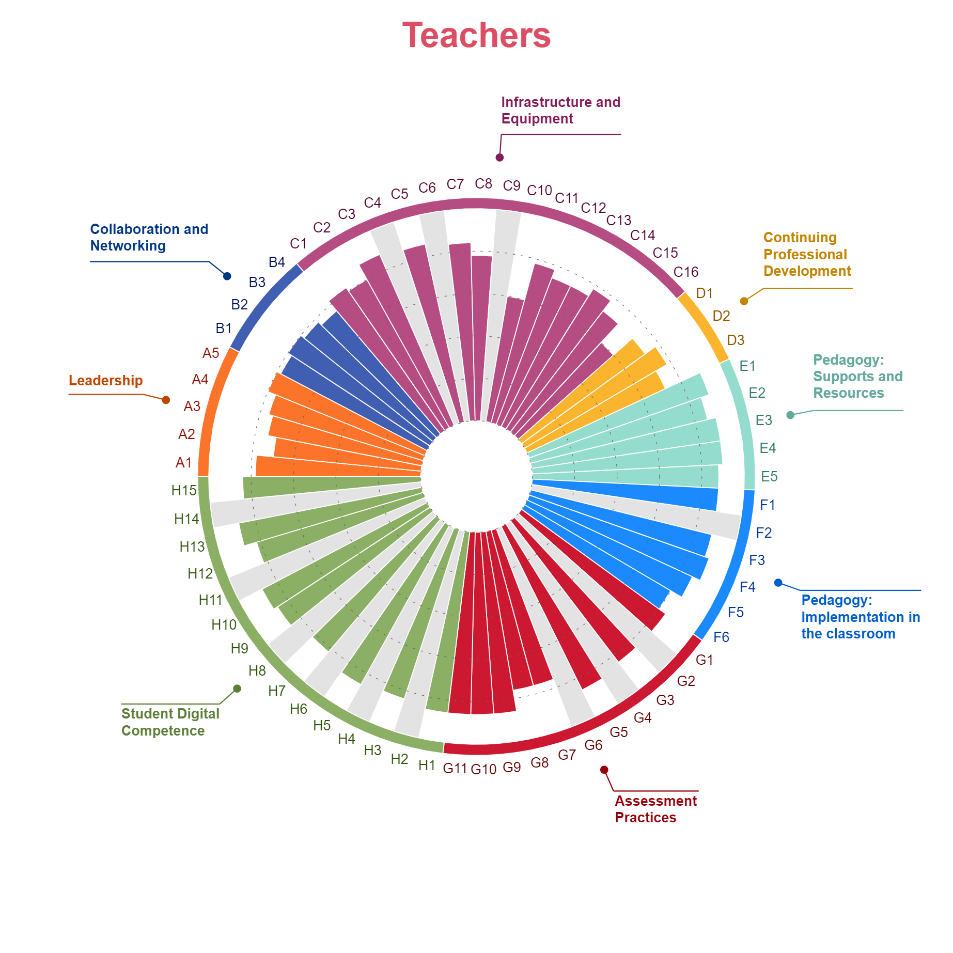
Regarding school leaders, as emphasized in Figure 12, they differentiated their answers per school cycle (for example, they offered lower scores for questions C15, C14, C16 and A4). The lack of equipment for online instruction and proper technology use for teaching and learning, however, is the most significant problem.
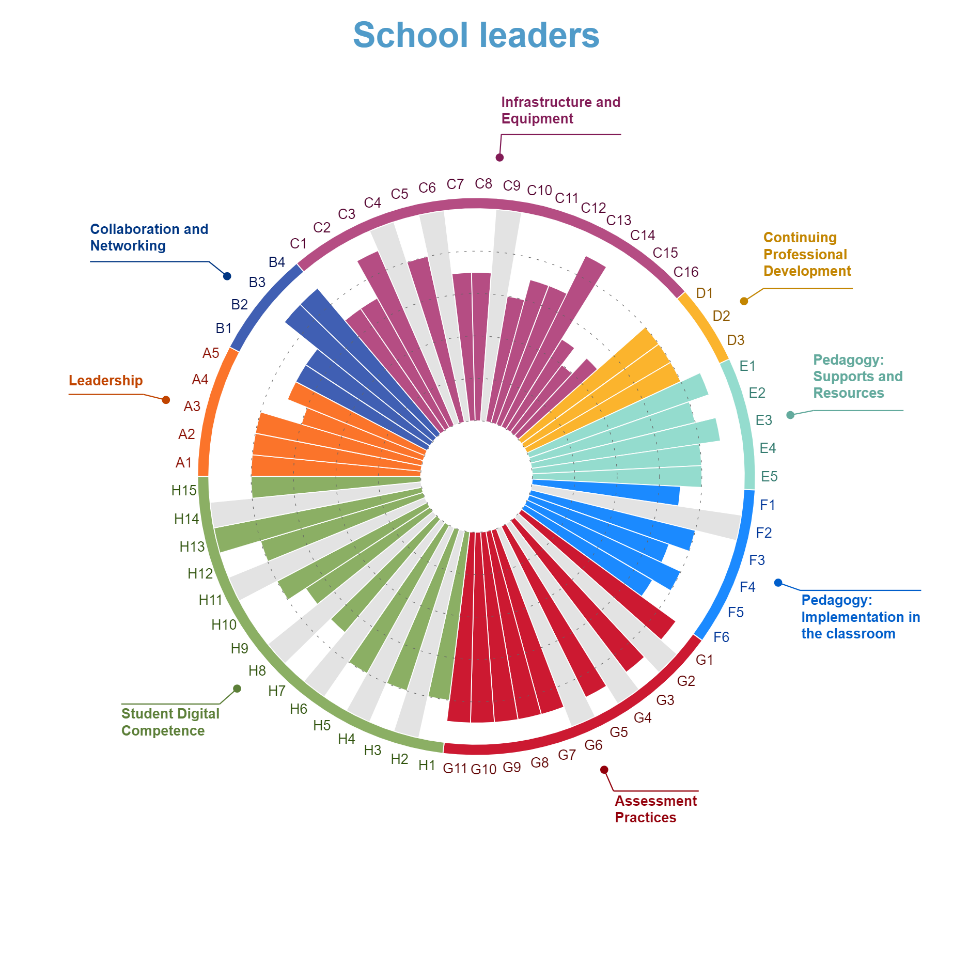
The data collected, the interviews and observations helped us create a realistic SWOT analysis for our school, and write a coherent action plan for the 2021-2022 school year, knowing what areas are our challenges and where we have to work to improve.
With SELFIE, schools can take a snapshot of where they stand in their use of digital technologies, taking on board views of teachers, students and school leaders. This self-assessment process can help start a dialogue within the school on potential areas for improvement. SELFIE also allows a school to monitor its progress over time. The purpose of our study was to gather data (related to areas like school leadership, collaboration and networking; infrastructure and equipment; continuing professional development; pedagogy – implementation in the classroom; assessment practices and students` digital competences) in order to build the school`s action plan for the following year, taking in consideration the fact that we were studying online for almost 2 years, due to the pandemics (and to the infection rates from our town, that prevented us returning to school for a long time.
Conclusions
Through a series of questions for teachers, school leaders and students, SELFIE measured the way digital technologies are used for teaching and learning at our school. Questions for school leaders focused mainly on strategies and practices at the school level related to the use of digital technologies. The questions for teachers are to mainly capture teaching practices and for students their experiences and learning practices related to the use of digital technologies. Schools can customise the tool by adding questions that suit their context and also, they can track progress by running another session in the following years. All the answers are anonymized, and, since SELFIE is hosted on a server owned and managed by the European Commission, the data gathered is subject to the Commission’s data processing rules.
The research conducted with the use of SELFIE (at “Petru Rareș” National College, a case-study school participating to the EduNetworks interventions on digital education in the 2020-2021 school year, has helped our school make important steps towards integrating digital technologies in school education.
The objectives of the school for 2021-2027, for the Erasmus Accreditation – presented in Figure 13), were established starting from these findings, therefore, the Erasmus Plan has the objective of increasing digital competences by 21% during accreditation to 194 pupils and 50 teachers (through blended-learning activities in eTwinning and Erasmus+).
We are raising students for a digital era, therefore, we should be prepared, as professionals, to embrace the challenges and find sustainable solutions. Our school used the data collected through this study as a basis for the Erasmus accreditation for school education; we built our application on these results and we are continuing to monitor the changes in our school, to keep growing as an eTwinning and European school. Therefore, the first year of Erasmus Accreditation (01.06.2022 – 31.08.2023) is dedicated to the where we are developing students` key-competences.
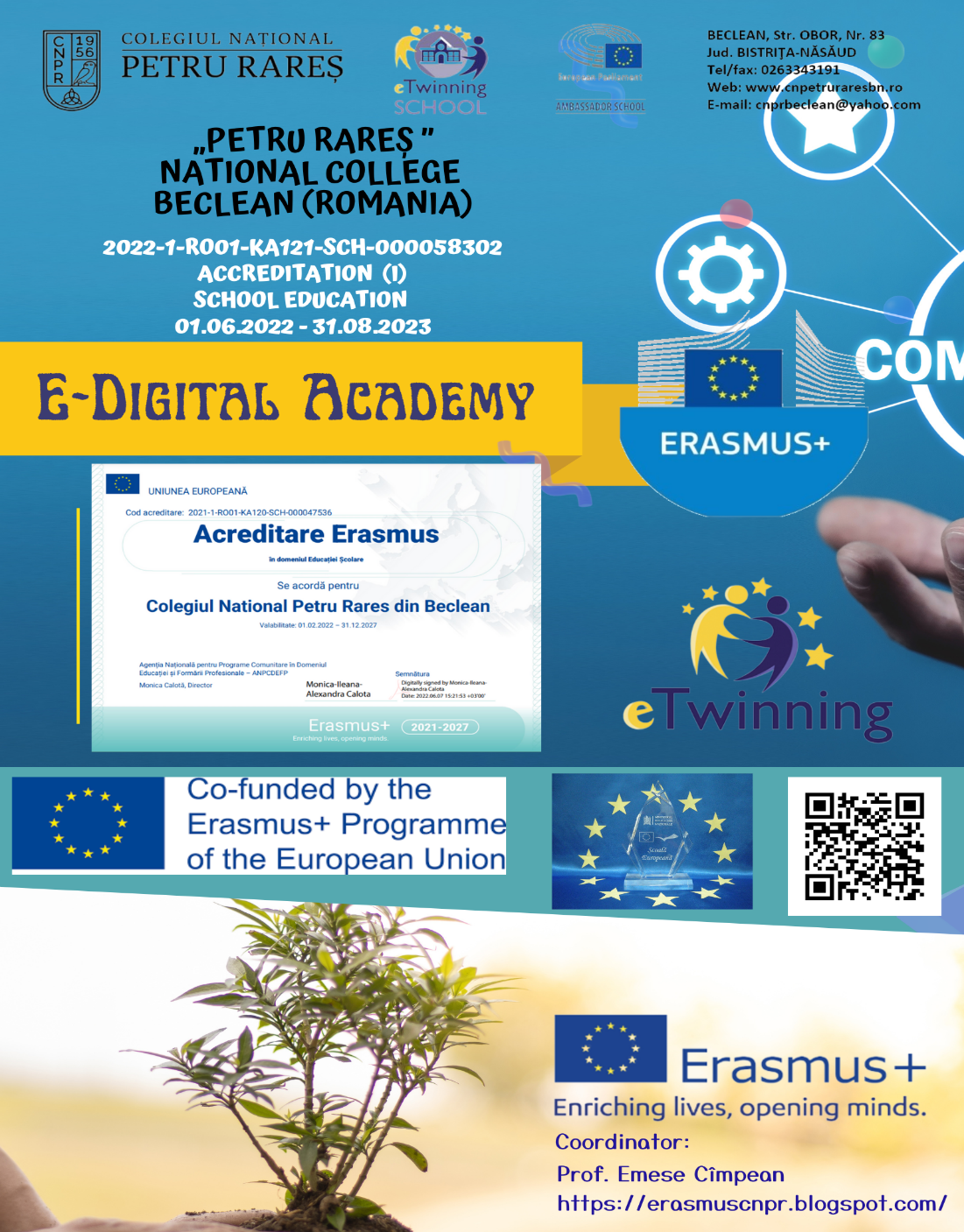
References
Baciu, C. (coord.), Bocoş, M.-D., & Magdaş, I.-C. (2022). Information and Communication Technology in Education. Dictionary of terms. (Volume I (A-K). CEEOL Press.
Bocoș, M.-D. (coord.), Răduț-Taciu, R., Stan, C., Chiș, O., & Andronache, D.-C. (2016). Dicționar praxiologic de pedagogie [The Praxeological Dictionary of Pedagogy] – (Volume I: A-D). Paralela 45 Publishing House.
Carretero Gomez, S., Vuorikari, R., & Punie, Y. (2017). DigComp 2.1: The Digital Competence Framework for Citizens with eight proficiency levels and examples of use. EUR 28558 EN, Publications Office of the European Union. Luxembourg. https://publications.jrc.ec.europa.eu/repository/handle/JRC106281
European Commission. (2019a). European Education Area. SELFIE. Resources. https://education.ec.europa.eu/selfie/resources
European Commission. (2019b). SELFIE. Supporting schools for learning in the digital age. https://ec.europa.eu/education/schools-go-digital_en
European Commission. (2019c). Directorate-General for Education, Youth, Sport and Culture. Key competences for lifelong learning. Publications Office, 2019. https://data.europa.eu/doi/
European Commission. (2021). The Digital Economy and Society Index — Countries' performance in digitisation (DESI). https://digital-strategy.ec.europa.eu/en/policies/countries-digitisation-performance
European Council. (2018). Eur Lex. Recommendation (2018/C 189/01) of the European Council of 22 May 2018 on key competences for lifelong learning https://eur-lex.europa.eu/legal-content/EN/TXT/PDF/?uri=CELEX:32018H0604(01)&rid=7
Redecker, C. (2017). European Framework for the Digital Competence of Educators: DigCompEdu, Punie, Y. (Ed.), EUR 28775, EN, Publications Office of the European Union. Luxembourg.
The Digital Education Action Plan. (2021-2027). https://education.ec.europa.eu/focus-topics/digital/education-action-plan#:~:text=What%20is%20the%20Digital%20Education,States%20to%20the%20digital%20age
Copyright information

This work is licensed under a Creative Commons Attribution-NonCommercial-NoDerivatives 4.0 International License.
About this article
Publication Date
10 April 2023
Article Doi
eBook ISBN
978-1-80296-961-0
Publisher
European Publisher
Volume
5
Print ISBN (optional)
-
Edition Number
1st Edition
Pages
1-1463
Subjects
Education sciences, teacher education, curriculum development, educational policies and management
Cite this article as:
Emese Cîmpean, M., & Bocoș, M. (2023). Digital Competences in School Education: Selfie. Current Perspectives and Challenges. In E. Soare, & C. Langa (Eds.), Education Facing Contemporary World Issues - EDU WORLD 2022, vol 5. European Proceedings of Educational Sciences (pp. 53-73). European Publisher. https://doi.org/10.15405/epes.23045.7

